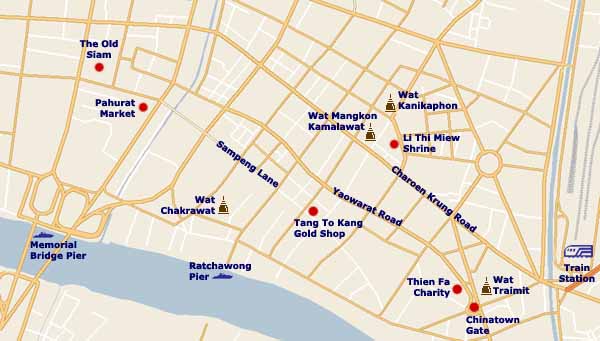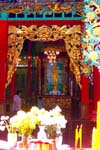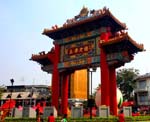Bangkok's Chinatown District
Bangkok's vibrant Chinatown district runs along Yaowarat Road from Odeon Circle, where a huge ceremonial Chinese gate unmistakably marks the entrance, up to the Ong Ang Canal, which marks the outer boundaries of the royal district. Yaowarat Road itself is lined with many gold shops, and Chinatown is indeed one of the better places to shop for gold. However, just off the road in either direction is a whole other world where, it is said, you can find just about anything.
Chinatown is an easy place to explore on foot, and in fact there really isn't any other way. Our own suggested walking tour takes in many of the sights of Chinatown, as well as the Indian market at Phahurat and the flower market further on.
Chinatown History
The Chinese community in Bangkok pre-dates the founding of the Thai capital in the city. Indeed, the land where the grand palace is today was originally a community of Chinese traders. When King Rama I decided to establish the capital on the site of the village of Bangkok, he asked the traders to move. They settled to the east of the new city, along the river. It may be hard to believe today, but the narrow Sampaeng Lane, which isn't even big enough for a car, was once Chinatown's main street.
In 1902, the foreign community, who settled on the river further east of Chinatown, petitioned the king for a larger road. Yaowarat Road was built as a result, and the celebration of the road's 111th birthday was the highlight of Chinatown's 2003 Chinese New Year celebration.
Chinatown Sights
Although there are many things to see in Chinatown, one of the biggest sights is the experience of the place as a whole. The best way to see the area is to pick a starting point and wander around.
Bangkok's Chinatown |
- Wat Traimit
- This small and rather uninteresting temple is home to the world's largest solid gold Buddha image, the five-ton-plus image sits in a small wiharn within the temple.
- Tien Fa Charity
- Just a short distance up Yaowarat Road from Odeon Circle is the small clinic run by th Tien Fa Charitable Foundation. In the courtyard of the old building is a large chapel to the goddess Ming.
- Historic Buildings
- Chinatown is home to many examples of the architecture of Bangkok's early years. About 14% of the buildings in the district have been designated as historical landmarks. Most of them are off on side streets. One of the most well known is the is the Tang To Gung gold shop on Sampaeng Lane around Mangkon Road.
 The alter within the Tien Fa Foundation courtyard.
The alter within the Tien Fa Foundation courtyard.
- Sampaeng Lane
 The crowded Sampaeng Lane on a typical day.
The crowded Sampaeng Lane on a typical day.- Chinatown's original main street is a small narrow alley which runs from the Phahurat Market all the way down to Songsawat Road. The lane is too small for cars, and is now a crowded market selling mostly inexpensive household items. Near the Tang To Gung gold shop is a very old Chinese pharmacy that is definitely worth a look.
- Wat Mangkon Kamalawat
- At the heart of Bangkok's Chinatown is the Chinese-Buddhist temple of Wat Mangkon Kamalawat, known in Chinese as Wat Leng Nui Yee. The temple is the center of festivities during important festivals such as Chinese new years and the vegetarian festival.
- Wat Kanikaphon
- This small temple in Bangkok's Chinatown has some interesting details, but its main claim to fame is the fact it was founded by a former madame who owned a brothel.
- Li Thi Miew Temple
- This Chinese temple is one of the more open and accessible of the many Chinese temples in Bangkok's Chinatown.
- Wat Chakrawat
- This large monastery, one of the three biggest in Bangkok, houses some very unusual buildings as well as a few crocodiles!
- Phahurat Market
- The market is home to a huge number of fabric and wedding stalls. Its really the center of a small community of Sikhs and other immigrants from the sub continent.
- The Old Siam
- If the array of sights and smells is a bit too overwhelming for you, head over to the Old Siam shopping center, where you will find more tourist-friendly western and Thai restaurants and fast food outlets.
Getting There
The easiest way to reach Chinatown is by boat. Alight at the Ratchawong Pier and walk up Ratchawong Road to Sampaeng Lane or Yaowarat Road. You can also alight at the Harbor Department Pier, which is closer to Odeon Circle; or you can also use Memorial Bridge Pier, right at the flower market.

No comments:
Post a Comment